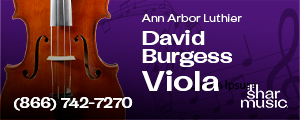
August 2011
Freedom, not Conformity: A Call to Young Musicians
August 27, 2011 20:55
Artistic freedom. To many music students, the phrase conjures forth images of a metaphorical no-man’s land – a forbidden territory that they are afraid to explore. What is to blame for this recent trend of stagnation? In my opinion, it is because of a ubiquitous mentality that “musical” playing relies on the overrated concepts of conformity and imitation. One cannot deny the flood of adept, technically sound and fluent musicians that have been surfacing over the last several decades; in fact, one could very well argue on a factual basis that those said players perform at a higher technical standard than did artists of the past. However, at what cost have they achieved such prowess? What other aspects of music have been lost along the (admittedly attractive) path to perfection? The answer to that, my dear colleagues, is artistry – the ability and the freedom to develop one’s own voice and present their own musical ideas in a unique, convincing way.
Musicianship over the past years has been leaning evermore onto the crutch of technique. Many young aspiring students consider great playing to be safe and clean, sometimes imbued with an artificial sense of virtuosity by movement. I find such colloquial playing to be rather stagnant, and, quite frankly, unimpressive. It is very easy to lump many modern players into the “school” of the soloist whom they are trying to imitate: Heifetz, Milstein, and Oistrakh, to name but a few. However, one must realize that those aforementioned artists became who they were NOT because of a mindset of imitation, but rather because of their courage to take risks in presenting ideas that had never been heard before. Much of their intrinsic ability to take risks and discover their musical identities came very early on in their careers because of the teaching style. Pedagogues like Auer, Zimbalist, Galamian, and DeLay constantly pushed their students to discover themselves, to experiment with different ideas to develop their own voice. Adversely, much of the teaching of today is focused on building solid technique (which the professors of old did as well – very much so) instead of developing that one unique voice in each student.
Fortunately, not all instructors teach in such a torpid way. There are plenty of wonderful pedagogues who offer priceless advice and inspiration. For example, this summer, I was privileged to work with the great violin teacher Sergiu Schwartz at the Bowdoin International Music Festival. Mr. Schwartz has an incredibly refreshing view on young musicians; he inspires the artist in every student to surface and to take charge. Ironically, he goes about this in a very intellectual way, helping his pupils analyze the harmonic structures of each piece and letting them interpret what they believe the composer intended. He then works with the student’s ideas, helping them to mold those thoughts and to present them in the most fluid, sensible way possible, all the while encouraging them to let go and let the heart take over when the time finally comes for the work to be performed. With his help this summer, my performances of Ravel’s Tzigane, the Schoenberg Phantasy, and the Bach Chaconne, along with numerous chamber works, were technically and musically the most successful I had ever done.
The world needs more teachers who help their pupils discover their inner voice, their musical soul. And while there are only so many soloist slots available to these pupils, this should not cause a young player to refrain from exploring their ideas and presenting material in a fresh, interesting way. However, this does not mean one should play in a musical muddle, throwing out random phrases willy-nilly just hoping to be “different”. In fact, it is quite the contrary - in the words of Sergiu Schwartz: “In-depth analysis and serious musicianship are essential to support individuality…in other words, to have the weight and authority, one must know the substance and message to be expressed.”
So, in conclusion, this is a message to all of my fellow students and colleagues. Analyze your music! Take risks! Explore different ideas, different sounds, and different facets of interpretation to ultimately construct your own unique tapestry. Too long have musicians hid behind a curtain of technique. It is time for us, the next generation, to make our own musical mark, to turn our backs on musical conformity and imitation, and to present something intelligent, something fresh, and something exciting.
More entries: May 2010
Violinist.com is made possible by...
Violinist.com Holiday Gift Guide
Dimitri Musafia, Master Maker of Violin and Viola Cases
International Violin Competition of Indianapolis
Johnson String Instrument/Carriage House Violins
Subscribe
Laurie's Books
Discover the best of Violinist.com in these collections of editor Laurie Niles' exclusive interviews.

Violinist.com Interviews Volume 1, with introduction by Hilary Hahn

Violinist.com Interviews Volume 2, with introduction by Rachel Barton Pine






